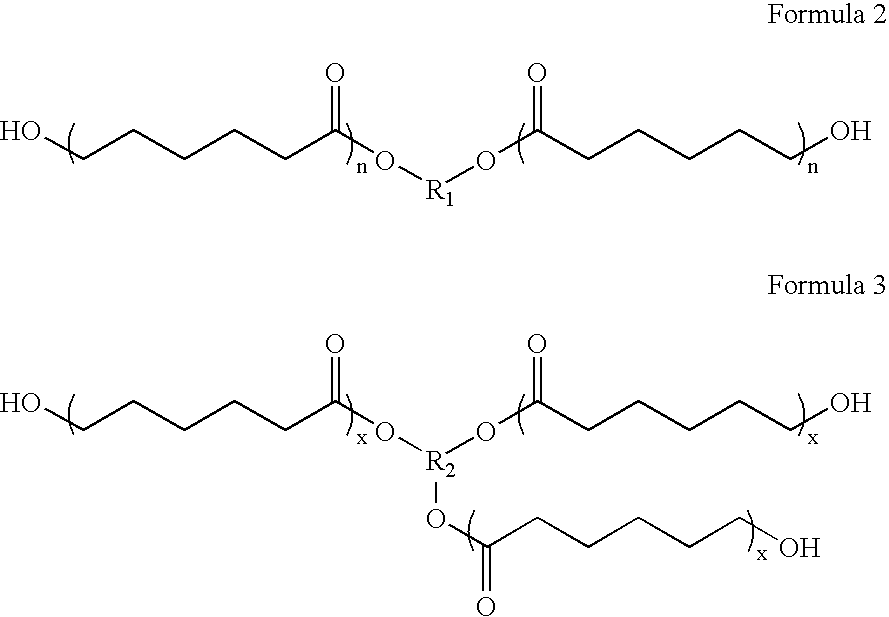Photoimageable coating composition and composite article thereof
a technology of epoxy resin and coating composition, which is applied in the direction of photosensitive materials, instruments, photomechanical equipment, etc., can solve the problems of reducing radiation intensity, thickness limitation, and conventional positive resists based on diazonaphthoquinone-novolac chemistry
- Summary
- Abstract
- Description
- Claims
- Application Information
AI Technical Summary
Benefits of technology
Problems solved by technology
Method used
Image
Examples
example 1
Effect of Solvent on Dry Film Photoresist Coating Defects
[0077]A solvent system suitable for use in the invention must: dissolve all components of a coating composition; provide a uniform wet coating; not result in the formation of an excessive amount of bubbles or other coating defects when the composition is dried on a coating web; allow formulation of the composition to a solid content and viscosity appropriate to the requirements of the coating method to be used; provide coatings that are sufficiently tack-free to allow roll winding and unwinding; and provide drying characteristics that are compatible with the physical limits of the coating equipment with respect to allowable coating application rates, belt speeds, and oven temperatures.
[0078]Although cyclopentanone has been shown (U.S. Pat. No. 6,391,523) to perform well as a solvent for photoresist compositions designed for spin coating applications, its use as a solvent in dry film coating applications leads to the formation ...
example 2
Effect of Coating Solvent Composition on Viscosity of SU-8 Resin Solutions
[0084]Coating solvents that provide good solvency for formulation components but do not result in high coating viscosity at solids contents useful in dry film coating processes are particularly desirable. To obtain information on the use of cosolvents to modify the viscosity on SU-8 resin containing formulations, a series of compositions was prepared by adding 0.5 gram of cyclopentanone, 1.0 gram of cosolvent, and 25.0 grams of a 74% by weight solution of SU-8 resin in cyclopentanone solvent to a 20 mL glass scintillation vial. The vials were sealed with screw caps and the contents mixed on the US Stoneware jar mill for 4-8 hours while heated using an infrared lamp. The resulting compositions contained 69.8% by weight SU-8 resin, 26.4% by weight cyclopentanone, and 3.8% by weight of cosolvent. The viscosity of each composition was measured at 23.0° C. using a Visco Easy Viscometer at 12 rpm using an L3 spindle...
example 3
Effect of Mixtures of 2-pentanone and 1,3-dioxolane on the Viscosity of Dry Film Photoresist Compositions
[0086]The viscosity of the dry film photoresist coating composition depends on the ratio of 2-pentanone to 1,3-dioxolane. To investigate this dependency, a series of photoresist compositions were prepared wherein the composition of the solvent mixture was varied from 0 to 100 weight percent of total solvent and wherein total solids, defined as the sum of SU-8 resin, Tone 0305 polyol, and Cyracure 6974 solids, was varied from 53% by weight to 57% by weight. In all compositions, the content of Tone 0305 polyol was 11.8% relative to the content of SU-8 resin and the content of Cyracure 6974 solids was 4.6% of the sum of the amounts of SU-8 and Tone 0305. The photoresist compositions were prepared by weighing the calculated amounts of SU-8 resin, Tone 0305 polyol, Cyracure 6974, 2-pentanone, and 1,3-dioxolane into 250 milliliter amber Boston round bottles. The bottles were sealed wit...
PUM
| Property | Measurement | Unit |
|---|---|---|
| weight ratio | aaaaa | aaaaa |
| weight ratio | aaaaa | aaaaa |
| epoxide equivalent weight | aaaaa | aaaaa |
Abstract
Description
Claims
Application Information
 Login to View More
Login to View More - R&D
- Intellectual Property
- Life Sciences
- Materials
- Tech Scout
- Unparalleled Data Quality
- Higher Quality Content
- 60% Fewer Hallucinations
Browse by: Latest US Patents, China's latest patents, Technical Efficacy Thesaurus, Application Domain, Technology Topic, Popular Technical Reports.
© 2025 PatSnap. All rights reserved.Legal|Privacy policy|Modern Slavery Act Transparency Statement|Sitemap|About US| Contact US: help@patsnap.com



